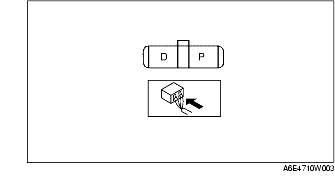
1. Verify that the battery is fully charged.
2. Verify that the drive belt deflection/tension is within the specification. (See DRIVE BELT DEFLECTION/TENSION INSPECTION.)
3. With the ignition switch at ON, verify that the generator warning light illuminates.
4. Verify that the generator warning light turns off after the engine is started.
1. Verify that the battery is fully charged.
2. Verify that the drive belt deflection/tension is within the specification. (See DRIVE BELT DEFLECTION/TENSION INSPECTION.)
3. Turn off all electrical loads.
4. Start the engine and verify that the generator rotates smoothly without any noise while the engine is running.
5. Measure the voltage at each terminal using a tester.
Standard specification
|
Terminal
|
IG-ON (V)
|
Idle (V) [20°C {68 °F}]
|
|---|---|---|
|
B
|
B+
|
13.0-15.0
|
|
P
|
Approx. 1.0 or less
|
Approx. 3.0-8.0
|
|
D
|
Approx. 0
|
*
|
1. Verify that the battery is fully charged.
2. Verify that the drive belt deflection/tension is within the specification. (See DRIVE BELT DEFLECTION/TENSION INSPECTION.)
3. Disconnect the negative battery cable.
4. Connect a tester capable of reading 120 A or above between generator terminal B and the wiring harness.
5. Connect the negative battery cable.
6. Turn off all electrical loads.
7. Start the engine.
8. Increase engine speed from 2,000-2,500 rpm.
9. Turn the following electrical loads on and verify that the current reading increases.
Reference value
Current possible for power generation (differs according to load)
[Conditions] ambient temperature 20°C {68 °F}, voltage 13.0-15.0 V, engine warm